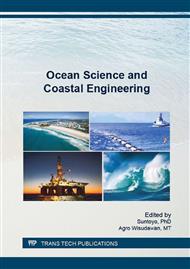p.3
p.9
p.16
p.21
p.27
p.34
p.41
p.46
Characteristics of High Growth Casuarina equisetifolia and High Inundation of Tsunami when Propagating through Greenbelt Vertical Rod
Abstract:
The tsunami waves when reached the coast has a potentially damage and large destroye, which has a velocity of 150-500 km/h and when arriving at the coast will sweep all existing buildings around the coast. The current research on tsunami wave has been done, but in general against buildings or scour. Research on the use of vegetation as an energy absorbers tsunami waves is still lacking. Pacitan coast is one of the coasts that are used to simulate the use of vegetation as a greenbelt in reducing tsunami wave. In observation of Casuarina Equisetifolia plants as greenbelt, plant age, density, planting pattern, stem diameter and the diameter of the limb into the goal in measuring. The measurement results will be used as the initial in the research use of greenbelt plants against tsunami waves. These measurements will continue to be done in intervals of 1 year to see the development of the plant. The measurement results of this investigation will serve as a field data input greenbelt plant modeling laboratory in order to obtain theoretical approach regarding the use of plants in reducing tsunami.
Info:
Periodical:
Pages:
21-26
Citation:
Online since:
January 2017
Authors:
Price:
Сopyright:
© 2017 Trans Tech Publications Ltd. All Rights Reserved
Share:
Citation:


